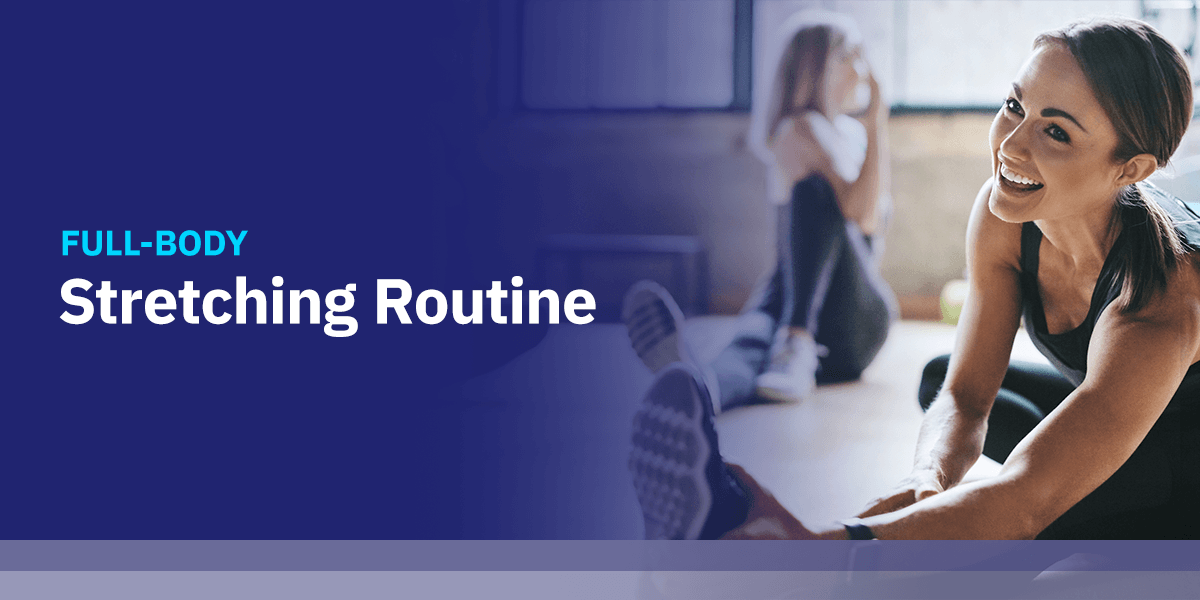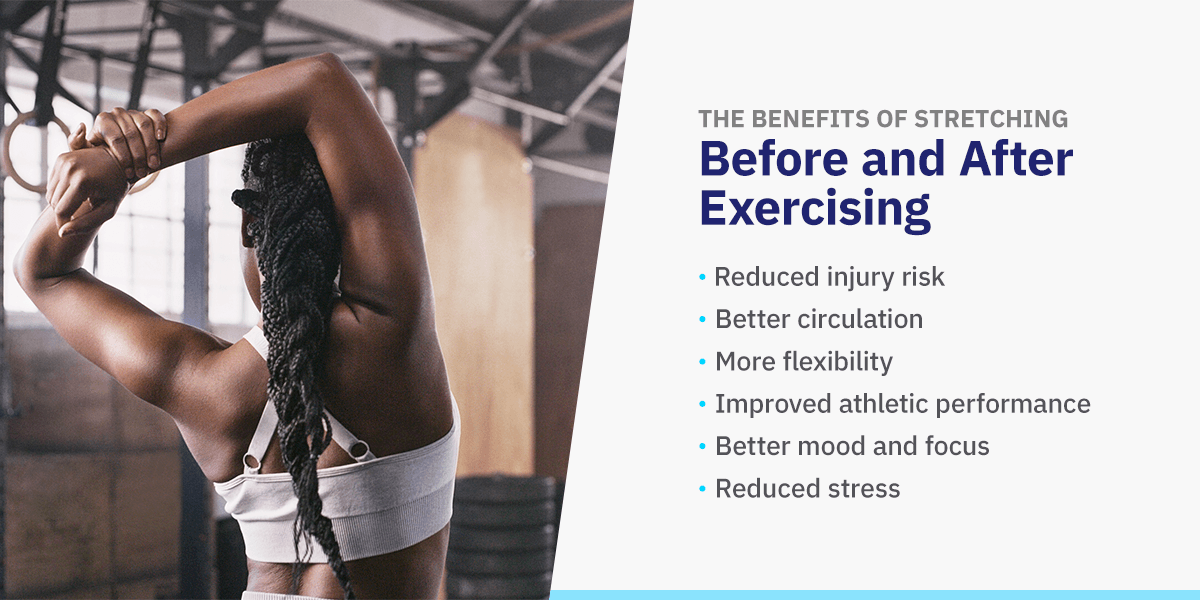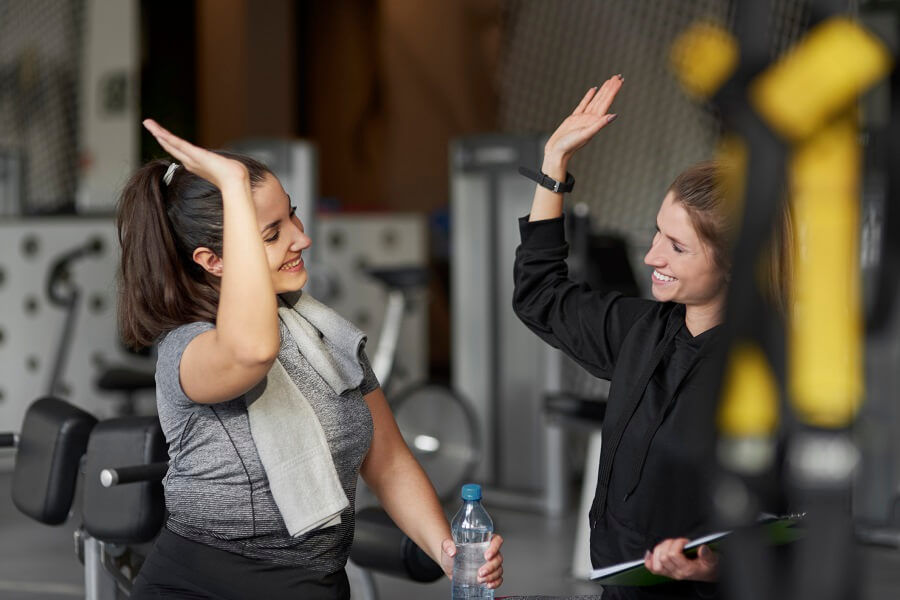Full-Body Stretching Routine
Full-Body Stretching Routine
Posted on: August 8, 2023 in Stretching
Stretching before and after a workout is a feel-good way to prevent injury, enhance circulation and relieve muscle tension, among other benefits. It maintains strong, healthy and flexible muscles, preventing them from becoming tight, tense or weak.
This article will explore the numerous benefits of stretching before and after a workout and different types of stretches that target some of the major muscle groups. Read on for plenty of tips to help you create a full-body stretching routine.
The Benefits of Stretching Before and After Exercising
Stretching before and after a workout can benefit both your physical and mental health. Some examples include:
- Reduced injury risk: Stretching may decrease the risk of injuring your joints and muscles during exercise.
- Better circulation: Stretching can improve oxygen levels and blood flow, helping deliver nutrients to your muscles.
- More flexibility: Stretching can help improve flexibility, allowing you to move more comfortably and perform daily tasks more easily.
- Improved athletic performance: Because it improves range of motion and flexibility while preparing the muscles for movement, regular stretching may improve your performance in physical activities.
- Better mood and focus: Stretching can boost your mood and help you feel more relaxed, allowing you to focus better on everyday tasks.
- Reduced stress: Stress can cause your muscles to become tense and tight. Stretching can loosen these muscles and help your body recover from stress.
Dynamic vs. Static Stretches
There are multiple ways to stretch, some types better suited for certain times than others. Two common styles of stretching are:
- Dynamic: Dynamic stretches are controlled movements designed to prepare the muscles, ligaments and other soft tissues for safe performance. They involve the active movement of a muscle or joint through its full range of motion, warming up your muscles for exercise. Examples of dynamic stretching include leg swings, lunges or trunk twists.
- Static: Static stretching involves standing, sitting or lying still, then holding a specific position for a period of time, up to about 45 seconds. This allows your muscles to loosen up after exercise. Examples of static stretching include a seated butterfly stretch or bending over and touching your toes.

Full-Body Stretch Routine
Whether you need stretches for more flexibility, balance, range of motion or relieving stress, you’ve come to the right place. Below are some stretches to try before or after a workout:
1. Calf Stretch
Calf stretches are recommended after running or whenever you have tight calves. Here’s how to do them:
- Stand facing a wall or the back of a chair. Place your hands on the surface in front of you to keep your balance.
- Put one foot in front of the other, keeping both of them flat on the ground. Straighten your back leg and bend your front knee slightly.
- Bend your front knee to lean toward the wall or chair. You should feel a gentle stretch in your back leg’s calf.
- Hold this stretch for about 30 seconds, then repeat on the other side.
Stop this stretch immediately if it causes pain in your Achilles tendon, where your ankle attaches to the calf.
2. Leg Swing
Leg swings are a great stretch to perform before a workout, working the hips, glutes and inner thighs. A good tip is to start with small swings, widening each swing gradually as your muscles loosen. Follow these steps:
- Stand up straight with your feet shoulder-width apart.
- Swing your right leg back and forth in front of your body while balancing on your left leg. Only go as far as what’s comfortable for you.
- Do this about 20 times before repeating it on the other side.
3. Hamstring Stretch
Hamstring stretches are excellent after a workout when your hamstrings are tight or even before going to bed. They loosen up the hamstrings and the lower back. Here’s how to do them:
- Sit on the floor with one leg straight out in front of you. Keep your opposite foot against your straightened leg’s inner thigh.
- Lean forward and reach for your toes while keeping your back straight.
- Hold for 30 seconds once you feel the back of your extended leg being stretched. Repeat on the other side.
4. Neck Circles
Neck circles can help loosen the muscles when your neck feels tight. Try holding this stretch longer on whichever side feels tighter. Here’s how to do neck circles:
- Drop your chin to your chest.
- Tilt your head to one side until you feel stretching along the opposite side of your neck.
- Hold for 30 seconds to a minute, then repeat on the other side.
5. Butterfly Stretch
Butterfly stretches are fantastic for stretching the back, glutes, thighs and hips. Here’s how to do them:
- Sit up straight on the floor. Bend your knees so that the soles of your feet touch, resembling the wings of a butterfly.
- Hold onto your feet or ankles. Engaging your abs and pressing your knees toward the floor, slowly lower your body toward your feet as far as possible.
- Hold this stretch for 30 seconds to a couple of minutes.
6. Lateral Raise
Lateral raises target the deltoid muscles, stabilizing the shoulders and upper body. They’re also a safe stretching alternative to arm circles, which can be a dangerous stretching exercise. Over time, arm circles can possibly lead to shoulder impingement syndrome or damage the rotator cuff muscles.
Lateral raises stretch the same deltoid muscles that are prone to injury in arm circles. They can be performed with dumbbells or a lateral raise machine, but for the sake of stretching, we recommend sticking with dumbbells. Here are the steps:
- Choose a dumbbell for each hand depending on your fitness level.
- Stand with your feet hip distance apart.
- Slowly raise your arms sideways up to your shoulder level.
- Descend your arms back to the original position, perpendicular to the floor. Repeat about 10 times.
7. Child’s Pose
Child’s pose is an excellent cooldown stretch after a workout or yoga, stretching the spine and releasing tension in the shoulders, back and chest. Here are the steps for child’s pose:
- Kneel and sit on your knees. Lean forward with your hips sitting over your feet and your arms stretched in front of you, pressing your chest to your knees.
- Hold this pose with your forehead resting on the floor, stretching your lower back for about 30 seconds to a minute.
If you experience pain in the knees or hips, try elevating them with a yoga block or pillow.
Make Stretching Part of Your Workout Routine at 5 Bridges Health & Fitness
At 5 Bridges Health & Fitness, we want to help you pave the way to a happier, healthier lifestyle — whether that’s stretching before a workout, attending a group fitness class or working with a personal trainer. If you’re ready to launch your fitness transformation, check out our gym membership plans and start building your perfect exercise routine today!



